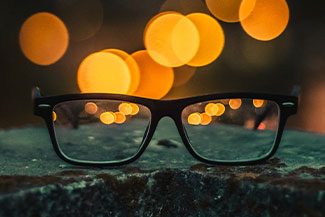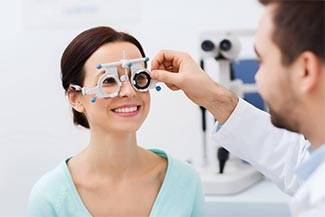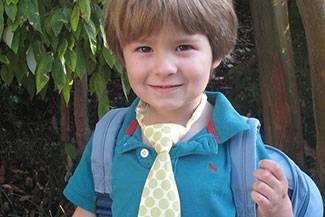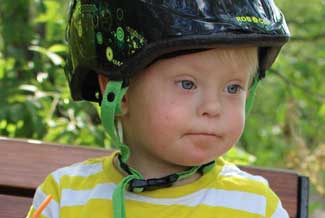-
Dissociated vertical deviation (DVD) is characterized by a slow upward drifting of one eye when the patient fixates with the other eye. Learn more about DVD and find out how vision therapy treats this condition.
-
Anomalous retinal correspondence (ARC) is a binocular condition often associated with strabismus (eye turn). Learn about ARC and how it can be treated.
-
When the third cranial nerve is damaged it can affect how your eye functions, leaving your eye unable to control specific actions. Learn about third cranial nerve palsy and how it can be treated.
-
Multifocals are not just for people over the age of 40. Children sometimes need them too. Multifocals may help them to keep focus in school and may alleviate eye strain, headaches, blurred vision, and fatigue.
-
Primitive reflexes are essential for the brain to develop. They start in utero and continue to develop as a child grows. However, retained primitive reflexes can result either from a problem at birth or during the first initial months of life. Vision therapy can help resolve retained primitive reflexes.
-
Meniere’s disease, a vestibular problem, can be exacerbated by issues related to the visual system. Vision therapy can help reduce dizziness related to visual dysfunction and offer some relief to patients suffering from Meniere’s disease.
-
People with anisometropia experience blurred vision because each of their eyes refracts a different amount of light. Left unaddressed, one eye becomes significantly weaker than the other, potentially leading to permanent vision loss. Vision therapy addresses anisometropia and strengthens the weaker eye.
-
Nystagmus is a complex optical condition that causes involuntary eye movements and blurred vision. Fortunately, vision therapy can help.
-
Prism eyeglasses are worn to correct double vision. Prisms also are used in vision therapy, which is made up of a series of eye exercises to help the eyes and brain communicate more efficiently to alleviate double vision and other conditions.
-
Beginning in adolescence and through their early 20s, young people should undergo annual functional eye exams that assess the visual skills necessary to succeed in school, sports, and everyday life. The start of the new school year is a good time to get these visual skills checked.
-
Having good visual skills is the key to being able to read, play sports, and perform many other tasks, but even people with excellent eyesight may lack vision skills. That’s where vision therapy can help.
-
Dyslexia causes children and adults to struggle with reading, writing and speaking, which in turn leads to learning difficulties. But are these learning difficulties caused by dyslexia or a vision problem — or both? And can they be treated by an optometrist?
-
Poor visual skills can affect many areas of life and can negatively impact performance at school, the office and on the sports field. Read on to find out the most common visual efficiency problems, and how vision therapy can help.
-
Have your child take our quiz to discover if he/she has functional vision issues that stand in the way of his academic achievement and quality of life.
-
Children with undetected vision problems can struggle with reading and writing, which can adversely affects their studies and quality of life. Read on to find out the ways a developmental optometrist can help.
-
Amblyopia or “lazy eye” is a neuro-developmental vision condition that begins in early childhood.
-
Studies show that children with vision problems are twice as likely to be diagnosed with ADD or ADHD as compared to their peers. Learn how vision therapy can help maximize your child's visual skills to reach their full potential.
-
Children with special needs are more prone to developing vision problems than the general population. These visual deficits often hamper their academic achievements. Read on to learn how vision therapy can help these children achieve their full potential.
-
-
Amblyopia, commonly referred to as Lazy Eye, occurs when the brain and the eye are not working in unison, resulting in decreased vision in an eye that otherwise seems healthy. The only treatment available which treats the amblyopia and not just the symptoms is Vision Therapy, also called Development Optometry.
-
Undiagnosed vision problems are at times at the root or an overlooked component of a child’s diagnosis with ADD/ADHD or a learning disability. By undergoing a thorough eye evaluation, you may discover that the issue is, in fact, a functional vision problem. Fortunately, this can be corrected with a highly effective vision therapy program.
-
Good vision is so much more than 20/20. A vision screening measures visual acuity only but does not uncover vision deficiencies, such as poor focus or tracking problems, convergence insufficiency, and other essential functional vision skills. These can have a profound effect on your child’s learning abilities and overall success in life.
-
Approximately 60% of stroke survivors develop some form of visual impairment, including diminished central or peripheral vision, eye movement abnormalities, or visual perceptual defects. Focus, double vision, balance, visual memory, and depth perception are all affected. A neuro-optometrist can help rehabilitate any of these and other resultant visual aberrations.
-
Just because someone has 20/20 vision, doesn't mean that they can see well. A large percentage of students pass vision screenings with flying colors, yet still experience serious functional vision issues impacting development, life functions and learning. Only a Functional Vision Exam can evaluate whether all essential visual skills are working correctly.
-
Syntonic phototherapy (light therapy) uses visible light frequencies (color) to improve visual attention and decrease any symptoms associated with various eye problems. This therapy benefits those with double vision, eye strain and fatigue, headaches, reduced peripheral vision, and more.
-
By training the eyes and brain to seamlessly work together, vision therapy effectively treats visual dysfunctions that interfere with a child’s reading and learning abilities.
-
Strabismus, also known as an “eye turn” or “cross-eye”, is a condition characterized by the improper alignment of the eyes. Vision therapy effectively treats this condition by teaching the brain and eyes to work together to correct the eye misalignment and thus achieve clear and comfortable vision.
-
Children often struggle with learning and sports as a result of undiagnosed vision problems — most commonly Convergence Insufficiency (CI). CI has been shown to affect a child’s reading ability, attention and overall school performance. Learn how vision therapy can treat this condition thereby leading to more success in school, work and in sports.
-
Keep Up-To-Date with our Vision Therapy Blog!
-
Those with Down syndrome (DS) can experience a range of visual problems and disorders, and can be at risk of developing vision-robbing ocular diseases, such as glaucoma. Read on to learn more and find out how vision therapy can help.
-
Those with autism spectrum disorder (ASD) can experience a range of visual problems and disorders, such as lazy eye, strabismus, light sensitivity, and the inability to track moving objects, among others. Read on to learn more and how vision therapy can help.
































